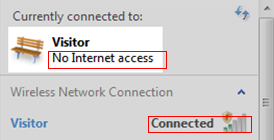How to troubleshoot if there is no internet connection when using 4G Mobile Wi-Fi(Case 1)
Note: This article is applied in the following situation: you can connect to the wireless network of 4G Mobile Wi-Fi, but none of your devices can get internet access and you might see the following icon on your computer.

Preparation: Please make sure your SIM card works fine when inserted into other 4G device or mobile phone, and make sure it allows to share internet access to multiple devices and not locked to specific phone or 4G device.
Then please insert the SIM card into the 4G Mobile Wi-Fi and refer to the instruction here to login the web management page of the MiFi device first, check the “Connection Status” and “IP Address” on Status page.

If the Connection Status shows Connected and IP address is not 0.0.0.0, please refer to this FAQ.
If the Connection Status shows Disconnected and IP address is 0.0.0.0, it means the 4G Mobile Wi-Fi is not connected to the internet yet. The reason can be that SIM card is not detected, SIM card is locked, SIM card’s supporting bands doesn’t match with the 4G Mobile Wi-Fi device, data usage has reached the limit or the 4G Mobile Wi-Fi’s default APN profile doesn’t match with the SIM card.
1: SIM card cannot be detected: “No SIM card” message appears on the screen, or SIM card status shows “Not found”

Or “No SIM Card” appears on Home page of tpMiFi App:

Solution:
1) Refer to here to install SIM card properly and make sure it has a good contact with the SIM card slot.
2) Reboot the MiFi device with SIM card inserted
3) Try a different SIM card to see if it can be detected
2: SIM card has been locked and PIN code required.
SIM card has been detected but SIM card Status shows “PIN locked” or “PIN required”
Solution: Refer to here to enter PIN code of your SIM card and unlock the SIM card.
3: SIM card’s supporting bands doesn’t match with the 4G Mobile Wi-Fi device
There is no 4G signal received and APN profile shows None(SIM card has been detected and not locked). Here is the screenshot on web interface, signal icon on the upper right side corner is greyed out with an “X” which means no signal and Profile shows “None”

On tpMiFi App, you will see “No Service”

Solution:
1) Reset the MiFi device to factory defaults: remove the back cover, use a pin to press and hold the reset hole until the device rebooting automatically.
2) If still the same, please check with your carrier which network type and bands are supported by your SIM card, then compare it with the network type and bands supported by the MiFi device. You could check specification of the MiFi device on our official website, for example, here is the network type and bands supported by M7350(EU) V7:

3) Try a different SIM card especially from different carriers
4: Data usage has reached the limit
TP-Link MiFi devices support to limit the data usage settings, so if you have enabled and reached the data usage limit, you will see Total/Monthly Used data is in red and also a red message “Data Usage has reached the allowance.” on Status page of the web interface.

And the cycle on Home page of tpMiFi App will be red as well:

Solution: Disable data usage limit or change the Data Usage Settings.
Via web interface:

Via tpMiFi App:

5: The 4G Mobile Wi-Fi’s default APN profile doesn’t match with the SIM card.
We have built in a lot of APN profiles for common mobile carriers in the world, that’s why MiFi devices usually can be plug and play, but if your carrier has updated their APN profile or some kinds of SIM card needs different APN profiles without our notice. In such cases, SIM card can be detected and there is good 4G signal but Connection Status shows “Disconnected”
Solution: Check if there is other available profile in the list for your carrier, or create an APN Profile manually by yourself.
The following information will be needed to create a profile manually: Profile Name, PDP Type, APN Type, APN, Authentication Type, Username and Password.
Profile Name can be anything you like such as your carrier name etc., but other parameters need to match with your carrier, if you are not so sure, please contact your carrier.
Two methods to create a profile manually:
1) on web interface of the MiFi device, please go to Advanced->Dial-up->Dial-up Settings page. Click “Create”


2)On tpMiFi App, go to Tools->Internet Settings->APN Management, tap “+” icon on the upper right side.


After you do the above troubleshooting, if still no internet access, please check the firmware version of your MiFi device and make sure it is on the latest firmware by referring to this FAQ.
Questa faq è utile?
Your feedback helps improve this site.

1.0_1494398383830f.jpg)
